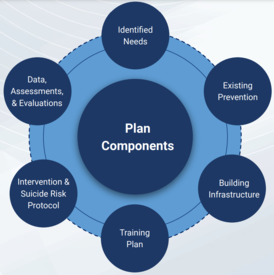
Support for Low-Performing Schools Shows Positive Results, Board Learns
Even with the dramatic increase in the number of schools found to be low performing based on last year’s test results, a number of schools that remained low performing from the 2018-19 school year made enough progress last year to exit that designation, according to a report to the State Board of Education this month.
Leaders of the Department of Instruction’s Office of District & Regional Support told members of the State Board of Education during their meeting this month that various efforts to support struggling schools in the state are helping improve student learning and school performance.
Of 488 schools identified as low performing in 2018-19 (designations that remained unchanged through 2020-21 because of the suspension of accountability measures during the pandemic), 146 schools emerged from low-performing status because of improved performance during the 2021-22 school year, said Alessandro Montanari, assistant director of the Office of District & Regional Support. And of the 146 schools, he explained, 45 had been low performing since the 2015-16 school year.
“So that’s clearly amazing work by our superintendents and district leaders and all of us in the department who put an emphasis on those schools that had been low performing for seven years,” Montanari said, “and we decided to make it a priority to help these schools try and exceed growth.” (Schools with state report card grades of D or F are not designated low performing if they exceed growth.)
Cynthia Martin, senior director of the Office of District & Regional Support, said that DPI’s CARES initiative, funded with federal pandemic relief funding, has been helping 81 continually low performing schools with intensive support.
“The CARES initiative has given us the personnel to help connect these [support] services so that [data from needs assessments completed by DPI] can be used by school leadership coaches to support the transition from needs identified into actions that schools can take,” Martin said.
|

She said that almost a quarter of the 81 CARES initiative schools were no longer low performing as a result of exceeding growth goals in 2021-22.
Martin also highlighted the work of the NC Instructional Leadership Academy, which has enrolled 1,500 district and school leaders as an effective strategy for school improvement.
“This initiative is essential to moving schools forward because the concentration of NC ILA is on the principal as an instructional leader,” Martin said. “NC ILA provides educational leaders an opportunity to learn best-practice methods and put them into action immediately with a job-embedded, practice-based curriculum.
State Superintendent of Public Instruction Catherine Truitt and board members said they’re encouraged by the department’s efforts, and additional funding from the legislature is needed to continue them once federal funding runs out in 2024.
“We need to expand the capacity of NC ILA because by all accounts, that’s working,” Truitt said. “We need to continue to replicate the CARES model for the intensive chronically low performing [schools] and that means asking for more coaches. That could be a second year of the biennium ask.”
Board Chairman Eric Davis said the additional support should be incorporated into the board’s budget requests to the legislature during its upcoming 2023 long session.
“If we adopt these recommendations, that should inform our legislative agenda,” Davis said, “and they’re very much in line with elements of our comprehensive plan. We should ask the legislature for what’s needed to put those items into motion.”
|

Analysis Shows Economically Disadvantaged Students Lost Less Learning in Low-Performing Schools with Federal Designations
In a related report, the State Board considered findings from an analysis by DPI’s Office of Learning Recovery & Acceleration showing that economically disadvantaged (ED) students who attended low performing schools receiving federal assistance in 2020-21 generally outperformed economically disadvantaged students who attended other, non-federally designated schools.
As with its previous studies focusing on pandemic-related learning effects, the OLR analysis measured student-level differences between projected and actual academic performance during school years 2017-2018 and 2020-2021. For this study, the OLR examined results from four federally designated school groups receiving additional support from DPI: Comprehensive Support and Improvement Schools (CSI) and Targeted Support and Improvement Schools (TSI), comparing those to “other” schools not designated as CSI or TSI for comparison.
All of the school groups, including the CSI/TSI federally designated schools, experienced declines in average academic progress for ED students between 2018 and 2021, ending the 2020-21 school year with negative average outcomes. However, as compared to their pre-pandemic ED peers attending the same school group, ED students within CSI and TSI schools experienced less learning loss than economically disadvantaged students in “other” schools, overall and within each tested subject.
ED students in CSI schools with low graduation rates experienced less loss overall than ED students in any other school group, and schools within CSI/TSI groups experienced 43% less loss across all subjects than schools not receiving CSI/TSI support. This suggests that pre-existing additional support may have helped schools at least partially offset the pandemic’s particular challenges for ED students.
These results can shape policy and practice in at least two ways, the report concludes: “First, understanding variation across students can help better target resources to those with disproportionate need. For example, within nearly all tested subjects, ED students were less likely to exceed academic expectations than their non-ED peers, and some ED students demonstrate greater need than others. Second, additional support structures may help ease future challenges, especially among disadvantaged students, implying that supports can be effective when used proactively.”
In response to an observation from State Superintendent Catherine Truitt about what made the difference in the CSI and TSI schools, Calen Clifton, an OLR research analyst who wrote the report, cited several strategies the schools employ, ranging from targeted professional development to additional support in their planning processes to additional funding as Title 1 schools.
Board Chairman Eric Davis said the findings from the analysis suggest that such approaches could help support the broader work of DPI’s Office of District & Regional Support.
“We should expand whatever those techniques are – which sound like a lot of individual connections to students – beyond what the federal government requires us to do,” Davis said.
|
NC Virtual Public School’s Role and Profile Continues to Grow, Director Tells Board

In presenting the 2021-22 annual report from the NC Virtual Public School to the State Board, director Mia Murphy ran through a long list of notable statistics and highlights from last year, including national recognition for the quality of courses the school offers.
Now in its 15th year, NCVPS is the second largest program of its kind in the nation behind Florida Virtual, Murphy said, having served a total of 710,736 student enrollments and with the 2021-22 school year marking its highest ever enrollment year.
Murphy pointed to several other accomplishments. Among them:
NC Virtual offered 12 new high school courses and four middle school courses including high school Economics and Personal Finance.
Graduated 80 teachers from the Teacher-in-Training Program that prepares educators to teach for NC Virtual.
In partnership with the Friday Institute, the Virtual Schools Network was launched in spring 2022 to enhance, connect and equip virtual schools within school districts with opportunities and resources that will enable educators to provide innovative virtual learning experiences for K-12 students.
NC Virtual also has been honored for high quality online learning from an international organization that focuses on quality assurance of digital teaching and learning offered by higher education and K-12 schools. The organization, Quality Matters, has recognized NCVPS with its Making a Difference for Students Award for exemplifying a focus on learners. Recipients demonstrate a commitment to ensuring high course quality and using different but valuable approaches to improving outcomes for students.
NC Virtual provides students across North Carolina access to online courses in many subject areas, including mathematics, science, English language arts, social studies, arts, advanced placement, honors, and world languages. Other courses include test preparation, credit recovery, and Occupational Course of Study (OCS).
The North Carolina Virtual Public School is a supplemental service to the public schools of North Carolina. Students enroll through their local public school, grades are reported to their public school, and their school awards credit. The courses use learning management and collaborative software to maximize student interaction in each class. NC Virtual teachers use the latest technologies to engage students as well as prepare them to be career and college ready.
Quality Matters noted that NCVPS demonstrated exceptional dedication to quality in digital learning and that the organization’s noteworthy commitment to improving learner outcomes includes the use of course review tools, professional development and research-supported standards to build quality assurance processes.
|
Mental Health Policy Report Outlines Needs of Districts, Schools
The second annual report to the General Assembly on the individual mental health plans, including a suicide risk referral protocol and training plan, was presented to the State Board this month as a discussion item. The report covers 332 public school units, including 115 traditional school districts, 207 charter schools and 10 regional/lab schools.
In presenting the report, Pachovia Lovett, DPI’s school social work consultant, showed the various components of the individual plans, which are to include identified needs existing prevention, building infrastructure and training plan.

In preparing their plans, districts and schools are asked to address several issues related to mental health such as universal promotion of mental and social-emotional wellness and prevention through core instruction, curriculum, and school environment and mental health training for school employees addressing the topics that include suicide prevention, substance abuse, teen dating violence and child sexual abuse prevention.
Districts and schools were also asked an open-ended question about what supports they need to improve compliance with the school mental health policy and improve outcomes. The top reported responses include these:
- More comprehensive training on the policy and the legislated topics with funding to adequately do so
- Additional permanent counselors, social workers, and nurses
- System for tracking interventions and outcomes
- More mental health community providers
- Consistent funding
- Stronger parent engagement
- Resources for substance abuse and teen dating violence
Board member Jill Camnitz asked Lovett if the plans are making a difference.
“Has it caused the districts to me more mindful of this work than they were previously?” Camnitz asked. “Has it focused attention?”
Lovett said she thinks the planning effort has helped to create more uniformity while also bringing more people into the process.
“Prior to this, there were always some individuals who have always been focused on this work,” Lovett said. “With the implementation of this plan, it brought in more folks to the table to get with those folks who have always been intentional about this work and to expand upon their efforts.”
|
|